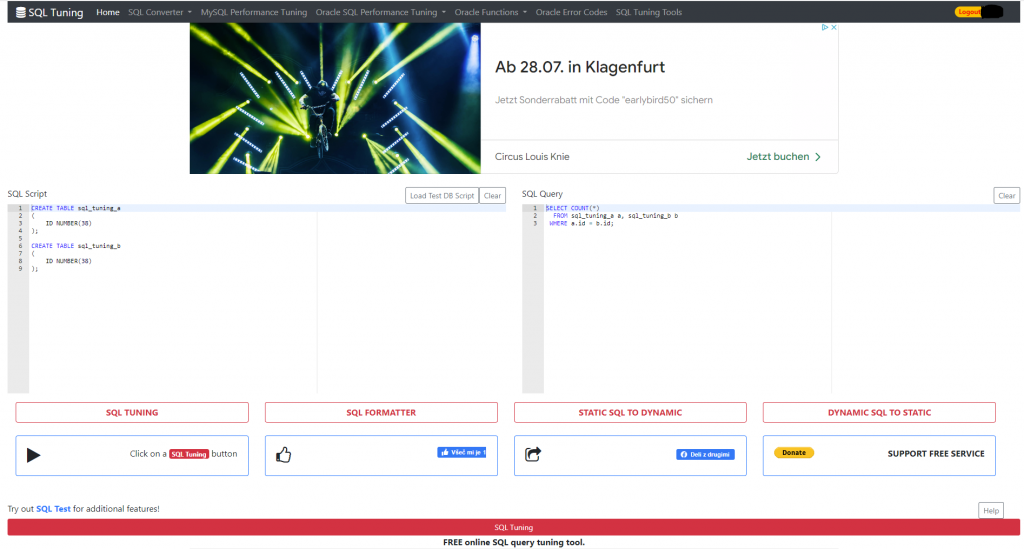For Oracle SQL Query Tuning you are welcome to use our free SQL Query Tuning Tool.

Rules for SQL query optimization:
1. SQL Performance Tuning team recommends using COUNT(1) instead COUNT(*) for SQL query performance optimization.
Example:
--Do not use:
SELECT COUNT(*)
FROM master;
--Use:
SELECT COUNT(1)
FROM master;2. Never compare NULL with NULL. Consider that NULL is not like an empty string or like the number 0. Also NULL can not be not equal to NULL (NULL != NULL).
Example:
SELECT COUNT(1)
FROM all_users
WHERE 1 = 1;
--Result: With condition 1 = 1 you will get result. But in this case you can also omit condition 1 = 1.
SELECT COUNT(1)
FROM all_users
WHERE NULL = NULL;
--Result: With condition NULL = NULL you will get result 0.
SELECT COUNT(1)
FROM all_users
WHERE NULL != NULL;
--Result: With condition NULL != NULL you will also get result 0.3. If you are using more than one table, make sure to use table aliases.
Example:
SELECT COUNT(1)
FROM master m, detail d
WHERE m.id = d.master_id;4. It is good practice to use table column names in an SQL query. This way the SQL statements will be more readable, but that is not the main reason. Example: If in INSERT statement you use SELECT * FROM x and at some point you add a new column in table x, SQL will return an error. The third reason why it is better to use table column names is to reduce network traffic.
5. In WHERE statements make sure to compare string with string and number with number, for optimal SQL query performance.
Example:
Note: Column id is NUMBER Data Type.
--Do not use:
SELECT id, apn, charging_class
FROM master
WHERE id = '4343';
--Use:
SELECT id, apn, charging_class
FROM master
WHERE id = 4343;6. Do not change column values in WHERE statements if possible, recommended by SQL Performance Tuning.
Example:
--Do not use:
WHERE SUBSTR(a.serial_id, INSTR(b.serial_id, ',') - 1) = SUBSTR(b.serial_id, INSTR(b.serial_id, ',') - 1)
--Use:
WHERE a.serial_id = b.serial_id7. Avoid using complex expressions.
Examples:
--Avoid:
WHERE serial_id = NVL(:a1, serial_id)
WHERE NVL(serial_id,-1) = ( 1, etc...)8. If you need to use SQL functions on join predicates that is okay, but do not use them with indexed table columns.
9. EXISTS vs. IN for sub queries If the selective predicate is in the sub query, then use IN. If the selective predicate is in the parent query, then use EXISTS.
10. NOT IN vs. NOT EXISTS vs. LEFT JOIN and NULL
Example:
--Try:
SELECT COUNT (1)
FROM emp
WHERE id NOT IN ( SELECT emp_id
FROM salary
);
--Try:
SELECT COUNT (1)
FROM emp e
WHERE NOT EXISTS ( SELECT emp_id
FROM salary s
WHERE s.emp_id = e.id
);
--Use:
SELECT COUNT (e.id)
FROM emp e, salary s
WHERE e.id = s.emp_id(+)
AND s.emp_id IS NULL11. RETURNING clause INSERT, UPDATE or DELETE can be used with RETURNING clause when appropriate. This way the number of calls to the database are reduced.
12. SQL Performance Tuning recommends using CASE statements. It is more efficient to run a single SQL statement, rather than two separate SQL statements.
Example:
--Do not use:
SELECT COUNT (1)
FROM emp
WHERE salary <= 1000;
SELECT COUNT (1)
FROM emp
WHERE salary BETWEEN 1000 AND 2000;
--Use:
SELECT COUNT (CASE WHEN salary <= 1000
THEN 1 ELSE null END) count_1,
COUNT (CASE WHEN salary BETWEEN 1001 AND 2000
THEN 1 ELSE null END) count_2
FROM emp;13. Use UNION ALL instead of UNION, if possible
Example:
--Do not use:
SELECT id, name
FROM emp_bmw
UNION
SELECT id, name
FROM emp_bmw_welt
--Use:
SELECT id, name
FROM emp_bmw
UNION ALL
SELECT id, name
FROM emp_bmw_welt14. SQL Performance Tuning recommends to use minimal number of sub queries, if possible.
Example:
--Do not use:
SELECT id, manufacturer, model
FROM cars
WHERE price = ( SELECT MAX(price)
FROM cars_bmw
)
AND year = ( SELECT MAX(year)
FROM cars_bmw
)
--Use:
SELECT id, manufacturer, model
FROM cars
WHERE (price, year) = ( SELECT MAX(price), MAX(year)
FROM cars_bmw
)15. SQL Performance Tuning recommends when cretin data are used frequently, it is a good idea to store them into intermediate tables.
16. SQL Performance Tuning OR vs. IN. Our tests showed that using IN in WHERE condition is a little faster then using OR.
Example:
--Do not use:
SELECT *
FROM CDRS_NR
WHERE RECORD_TYPE = 'MTC'
OR RECORD_TYPE = 'MOC'
OR RECORD_TYPE = 'SMSO'
--Use:
SELECT *
FROM CDRS_NR
WHERE RECORD_TYPE IN ('MTC', 'MOC', 'SMSO')17. Use a Power of Oracle Analytic Functions
On first look both SQL queries deliver the same result, but if we have in table RECORDS_NOT_CHARGED around 5.000.000 records the execution time of first SQL would be a few hours. Second SQL which is using Analytic Functions is executed in 2,5 minutes. This is a great performance improvement!
Example:
--Do not use:
SELECT nc.session_id, nc.msisdn, nc.served_imsi, MIN(nc.datum) datum
FROM RECORDS_NOT_CHARGED nc
WHERE nc.charged = 0
AND (EXISTS ( SELECT 1
FROM RECORDS_NOT_CHARGED m
WHERE m.session_id = nc.session_id
AND m.msisdn = nc.msisdn
AND m.datum >= nc.datum
AND (m.couse_for_cdr_closing ='Normal release'
OR m.couse_for_cdr_closing ='Abnormal release'))
OR (SYSDATE - nc.datum) >= 2)
AND NOT EXISTS ( SELECT 1
FROM RECORDS_NOT_CHARGED nca
WHERE nca.session_id = nc.session_id
AND nca.msisdn = nc.msisdn
AND (nca.record_sequence_number = '1' OR nca.record_sequence_number IS NULL))
GROUP BY nc.session_id, nc.msisdn, nc.served_imsi;
--Use:
SELECT DISTINCT session_id, msisdn, served_imsi, min_datum AS datum
FROM ( SELECT nc.session_id,
nc.msisdn,
nc.served_imsi,
nc.datum,
nc.couse_for_cdr_closing,
MIN(nc.datum) OVER (PARTITION BY nc.session_id, nc.msisdn, nc.served_imsi) AS min_datum,
MIN(nc.record_sequence_number) OVER (PARTITION BY nc.session_id, nc.msisdn, nc.served_imsi ORDER BY nc.record_sequence_number NULLS FIRST) AS min_record_sequence_number,
SUM( CASE
WHEN (nc.record_sequence_number = '0' OR nc.record_sequence_number = '1' OR nc.record_sequence_number IS NULL) THEN
1
ELSE
0
END
) OVER (PARTITION BY nc.session_id, nc.msisdn, nc.served_imsi) AS count_rsn_1_or_null
FROM RECORDS_NOT_CHARGED nc
WHERE nc.charged = 0 ) a
WHERE (a.couse_for_cdr_closing IN ('Normal release', 'Abnormal release')
OR (sysdate - a.min_datum) >= 2)
AND count_rsn_1_or_null = 0;